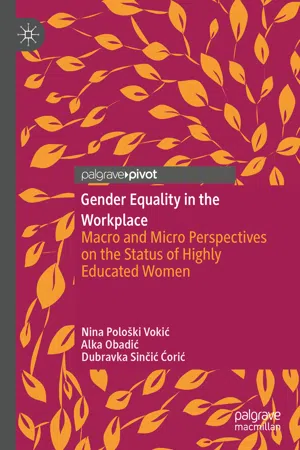
Gender Equality in the Workplace
Macro and Micro Perspectives on the Status of Highly Educated Women
- English
- ePUB (mobile friendly)
- Available on iOS & Android
Gender Equality in the Workplace
Macro and Micro Perspectives on the Status of Highly Educated Women
About this book
Focusing on the status of highly educated women in the workplace, this book examines how a particular demographic and workforce group can help to close the gender gap worldwide. Despite contributing to the substantial fall of differentials between men and women on a global scale, the demographic of highly educated women is rarely explored in terms of its impact on gender equality. Drawing on both macro- and micro-level perspectives, this book analyses the theory behind gender segregation and initiatives for women's inclusion, as well as offering empirical accounts of women's experiences in the workplace. The authors have written a timely and valuable book that will appeal to both researchers of diversity and inclusion in the workplace, but also policy-makers and practitioners involved in HR.
Frequently asked questions
- Essential is ideal for learners and professionals who enjoy exploring a wide range of subjects. Access the Essential Library with 800,000+ trusted titles and best-sellers across business, personal growth, and the humanities. Includes unlimited reading time and Standard Read Aloud voice.
- Complete: Perfect for advanced learners and researchers needing full, unrestricted access. Unlock 1.4M+ books across hundreds of subjects, including academic and specialized titles. The Complete Plan also includes advanced features like Premium Read Aloud and Research Assistant.
Please note we cannot support devices running on iOS 13 and Android 7 or earlier. Learn more about using the app.
Information
1. Introduction
Abstract
Keywords
Gender inequalityGender equalityGender segregationHighly educated womenTable of contents
- Cover
- Front Matter
- 1. Introduction
- 2. Gender Inequality: General Areas of Gender Segregation
- 3. Gender Inequality: Specific Areas of Gender Segregation
- 4. The Consequences of Gender Segregation in the Contemporary Work Environment: Barriers to Women’s Employment, Development and Advancement
- 5. Gender Equality Initiatives and Their Benefits
- 6. Previous Findings about the (In)Equality of Highly Educated Women
- 7. Macro Perspectives on the Equality of Highly Educated Women: Focus on EU-28
- 8. Micro Perspectives on the Equality of Highly Educated Women: Their Perceptions of Career Development
- 9. Conclusion: Highly Educated Women and the Future of Equality
- Back Matter